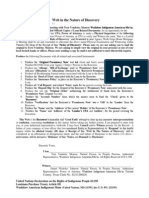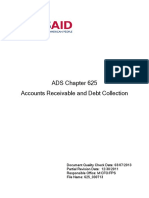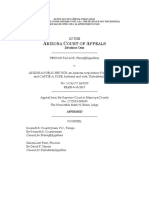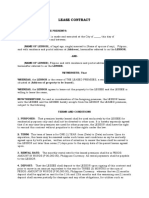The Doctrine of Merger 2002
The Doctrine of Merger 2002
Uploaded by
mptacly9152Copyright:
Available Formats
The Doctrine of Merger 2002
The Doctrine of Merger 2002
Uploaded by
mptacly9152Original Description:
Copyright
Available Formats
Share this document
Did you find this document useful?
Is this content inappropriate?
Copyright:
Available Formats
The Doctrine of Merger 2002
The Doctrine of Merger 2002
Uploaded by
mptacly9152Copyright:
Available Formats
The Doctrine of Merger
By Holly H. Alderman, Esq.
Most first year law students are familiar with the doctrine of merger which states that
when one entity obtains both a greater and a lesser interest in land to the same piece of
real property, the lesser interest merges into the greater interest and is thereby
extinguished. While many practitioners apply this doctrine without pause, this author has
seen many cases where it is truly inapplicable, it is adverse to the intention of the parties
or otherwise creates an unjust result for a third party. This article will briefly discuss the
history of the doctrine of merger, its application under the majority rule and from a title
insurance underwriters perspective.
HISTORY
According to one commentator, the doctrine of merger arose shortly after William the
Conqueror claimed title to all land in England. Burkhart, Freeing Mortgages of Merger,
40 Vand. L. Rev. 283, 290 (1987). (Citing G. Cheshire, The Modern Law of Real
Property 12 (9th ed. 1962)). For a variety of reasons existing at that time, the primary
items of value were land and cattle. Because there were few, if any, written land records
in existence, possession was the method of establishing protecting, and evidencing
ownership to real property. In order to simplify the various ownership interests in real
property, the doctrine of merger came into existence. For example, if A owns Blackacre
together with an appurtenant easement over Greenacre and later acquires fee simple title
to Greenacre, As easement interest in Greenacre would merge into his fee simple interest
in Greenacre and be extinguished. If A were later to sell Greenacre, such an easement
appurtenant to Blackacre might not be readily apparent to the purchaser. Using The
doctrine of merger to extinguish it and thereby simplify the status of title, A would need
to reserve said easement as an appurtenance to Blackacre if and when he later conveys
Greenacre to a third party.
Because interests in title are now memorialized in writing and are required to be of record
in most states in order to be respected vis a vis third parties, one commentator suggests
that its application creates absurd results in todays environment and furthermore, that it
should not apply to mortgage for the following reasons. 40 Vand. L. Rev. at 304.
First, the mortgage is not an interest in land from a historical perspective and second, the
doctrine of merger creates many onerous results. For the reader who is interested in a
detailed analysis of the history of mortgages, the doctrine of merger and the reason the
doctrine should not apply to mortgages, this author highly recommends the Vanderbilt
Law Review article cited herein. Regardless, the following is a condensed synopsis. The
term "mortgage" comes from the French word "gage", meaning a pledge of ones
property to secure an obligation, and the Latin word "mort." Originally, a mortgage was
known as a mort gage, in other words a dead gage. This term was used because the lender
had possession of the property pledged by the debtor and the right to collect all of the
crops and other profits derived from the property as interest. None of the profits were
2002 Investors Title Company
used to reduce the principal amount of the debtors obligation. Although interest was not
prohibited by law at this time, the English church prohibited interest as a form of usury.
Accordingly, "a Christian lender who died while holding a mort gage died as a sinner,
and his personal property was forfeited to the monarch." 40 Vand. L. Rev. at 306. It is
likely that this sentiment toward usury coupled with the fact that the gagee was not
considered to have actual seisen to, or a recognized estate in land meant that the courts
would not recognize an action brought by the gagee to regain possession of the land if
ousted by third party or even if ousted by the gagor himself. 40 Vand. L. Rev. at 304.
As the form of mortgages evolved, many lenders included a forfeiture clause in the gage.
If the debtor did not pay the debt, his title to the land was forfeited to the lender. By
having possession to the land already, the lender avoided the need to go to court to
enforce the forfeiture clause. As time when on, the character of a mortgage was altered
further to include a grant of a term of years interest (usually a very long one) subject to
the condition that said conveyance would be void upon repayment of the debt. Unlike the
earlier form of gage, this Thirteenth Century form of mortgage created an interest in land
for the lender. Accordingly, the doctrine of merger could apply. The mortgage as we
know it today went through numerous other modifications to satisfy feudal law concepts
and goals that at times would or would not permit an interest in a mortgage to be subject
to the doctrine of merger. By the middle of the Twentieth Century in the United States,
only eight states Alabama, Georgia, Maine, Maryland, Massachusetts, New Hampshire,
Pennsylvania, and Rhode Island still adhered to the theory that a mortgage conveys title
to the mortgagee and are thus appropriately subject to the doctrines application. 40
Vand. L. Rev. at 323, 324.
APPLICATION
Disregarding whether a mortgage creates an interest in land to which the doctrine of
merger is applicable, which is frequently the case when litigated, its application can
create unduly harsh and often absurd results. Unduly harsh results frequently occur when
the doctrine is applied to merge a lenders mortgage interest into its fee interest that was
acquired via a deed in lieu of foreclosure. If the deed in lieu of foreclosure is later set
aside by a trustee in bankruptcy, the lenders mortgage interest is no longer in existence
and he finds himself in the unenviable position of an unsecured creditor. Similarly, to the
extent junior liens have attached to the property, the lender will be unable to clear title of
these junior liens, a benefit the lender would have enjoyed had it foreclosed on its
mortgage interest. If a property owner executes a deed in lieu and was not personally
liable on the note secured by the mortgage, the deed in lieu may be challenged for failure
of consideration. Similarly, if the note was non-recourse, a deed in lieu may be attacked
due to the failure of consideration. Without the property or an obligation for which the
borrower is personally liable, the lender will be left with nothing in the event such a
conveyance is set aside.
Granted, these unduly harsh results can be prevented by the lender if he is willing to
proceed with a foreclosure rather that accepting a deed in lieu, but is that a desired result
when it will cost more money and a deed in lieu can achieve the outcome desired by the
2002 Investors Title Company
parties absent the doctrine of merger? Most would think not. The application of the
doctrine of merger can produce an equally adverse effect on an innocent third party. For
example, if the holder of a leasehold interest in real property grants that interest as
security for a debt, later acquires the underlying fee simple interest which thereby
extinguishes his leasehold interest, the leasehold interest pledged to his lender no longer
exists and the lender has nothing. Similarly, merger might operate to destroy a term for
years when the lessee acquires a life estate in the same land, even if the term for years
would have lasted longer than the life estate. Since courts of law would apply the doctrine
of merger to reach the absurd results described previously, in the late 1600s the courts of
equity started to hold that the doctrine of merger applies only if the holder of the two
property interests intend them to merge.
Today, the majority of the states in the United States follow the historical lead of
Englands court of equity. The intention of the party controls whether or not the doctrine
of merger applies. Thus, it is wise to state the intention of the party receiving the second
interest in the instrument conveying said interest. Unfortunately, some more modern
court decisions have disregarded the stated intention to produce results that both defy and
support a logical intention. 40 Vand. L. Rev. at 345. (Citing Crosby v. Chase, 17 Me. 369,
369 (1840); Hardin v. Boyd, 113 U.S. 756, 765-76 (1885); Allen v. Glenn, 87 Ga. 414,
13 S.E. 565 (1891); Shaver v. McCloskey, 101 Cal. 576, 36 P. 196 (1894); Jenks v.
Shaw, 99 Iowa 604, 610, 68 N.W. 900, 902 (1896); McGovney v. Gwillim, 16 Colo.
App. 284, 287, 65 P. 346, 347 (1901); Contra Ford v. Nesbitt, 72 Ark. 267, 269, 79 S.W.
793, 794 (1904); Katz v. Obenchain, 48 Or. 352, 358, 85 P. 617, 620 (1906); Sullivan v.
Saunders, 66 W. Va. 350, 353, 66 S.E. 497, 498 (1909); Kern Valley Bank v. Koehn, 157
Cal. 237, 239, 107 P. 111, 112 (1910); Austin v. Edwards, 201 Ala. 532, 533, 78 So. 886,
887 (1918); Small v. Cunningham, 120 N.W.2d 13 (N.D. 1963); Fowler v. Carter, 77
N.M. 571, 575, 425 P.2d 737, 740 (1967); Eldridge v. Salazar, 81 N.M. 128, 464 P.2d
547 (1970); Contra 200 E. 64th St. Corp. v. Manley, 37 N.Y.2d 744, 337 N.E.2d 133, 374
N.Y.S.2d 621 (1975); Quality Fin. Co. v. Bourque, 315 So. 2d 656 (La. 1975); Floorcraft,
251 So. 2d 138 (Fla. Dist. Ct. App. (1971)).
Many of these cases include fact patterns where a lender has a mortgage interest in the
property and then acquires the fee simple interest via deed in lieu of foreclosure. When
the lender later sells or conveys the property to a third party in an arms length transaction,
the courts conclude that the lender intended its interest to merge and thereby to convey to
said third party fee simple title unencumbered by the mortgage. Since there are cases
where the court has applied the doctrine of merger notwithstanding the express intention
of the parties otherwise, and vice versa, it is prudent in all jurisdictions to obtain a
cancellation of any mortgage not being assumed rather than relying on the doctrine of
merger. In those states that have adopted formal title practice standards that specifically
state a title examiner may treat the mortgage lien as merged into the fee title when the
mortgagee owns both the fee and the mortgage at the time of the conveyance, such a
cancellation or release is not necessary. As of 1987, the states which had adopted such
standards included Maine, Minnesota and Ohio. Burkhart, Freeing Mortgages of Merger,
40 Vand. L. Rev. at 361 (1987).
2002 Investors Title Company
TITLE INSURANCE UNDERWRITERS PERSPECTIVE
Due to the uncertainty of how courts will interpret the doctrine of merger, most title
insurance underwriters are reluctant to eliminate lesser interests reflected on the public
record based upon the application of this doctrine. Accordingly, it is best to report all
lesser interests not specifically canceled or released of record. If the proposed insured has
one interest and wishes the doctrine of merger to apply when acquiring a second interest,
this author recommends that the title lawyer communicate this desire to the title insurance
underwriter. Thereafter, the title insurance company can take exception to the lesser
interest and include a note which reads as follows: "Upon receipt of satisfactory
confirmation that the proposed insured has acquired fee simple title to [both the benefited
and burdened parcel] [both the leasehold interest and fee simple interest] [description of
interests to be merged] and the document conveying said interest expresses the parties
intention to have the lesser interest merge into the greater interest, this exception shall be
deleted in its entirety."
In any event, title lawyers should remember that it is best to first consult their title
insurance underwriter or at a minimum use caution when applying the doctrine of merger
as the basis for determining the status of title.
2002 Investors Title Company
You might also like
- Deed of Assignment of Shares TemplateDocument2 pagesDeed of Assignment of Shares Templateczabina fatima delica79% (24)
- Deed of Family Arrangement For Release of Property in Favour of Other Beneficiaries in Consideration of AnnuityDocument3 pagesDeed of Family Arrangement For Release of Property in Favour of Other Beneficiaries in Consideration of AnnuityshekhawatrNo ratings yet
- Lease - 112 - 1 Chef LaneDocument17 pagesLease - 112 - 1 Chef LaneDon HillNo ratings yet
- Public Wealth Rebate NoteDocument1 pagePublic Wealth Rebate NoteKristin Cantley Snell100% (1)
- American Voters Vs Bankers Vol 2Document351 pagesAmerican Voters Vs Bankers Vol 2Charlton Butler100% (1)
- Memorandum of LawDocument13 pagesMemorandum of LawPeter Papoulias100% (1)
- 27 F.3d 850 29 Fed.R.Serv.3d 1272Document38 pages27 F.3d 850 29 Fed.R.Serv.3d 1272Scribd Government DocsNo ratings yet
- Edwin Vieira, Jr. - What Is A Dollar - An Historical Analysis of The Fundamental Question in Monetary Policy PDFDocument33 pagesEdwin Vieira, Jr. - What Is A Dollar - An Historical Analysis of The Fundamental Question in Monetary Policy PDFgkeraunenNo ratings yet
- The UNITED NATIONS Convention On International Bills of Exchange and International Promissory NotesDocument8 pagesThe UNITED NATIONS Convention On International Bills of Exchange and International Promissory NotesDanton Lawson100% (3)
- Bid Bond SF24-1Document2 pagesBid Bond SF24-1mptacly9152100% (2)
- Examiners' Report 2014: LA3003 Land Law - Zone A Specific Comments On QuestionsDocument15 pagesExaminers' Report 2014: LA3003 Land Law - Zone A Specific Comments On QuestionsAnannya GhoshNo ratings yet
- Public Debt FlowchartDocument1 pagePublic Debt FlowchartRbNo ratings yet
- Notice of Intent Veripro Bofa 2tdDocument4 pagesNotice of Intent Veripro Bofa 2tdValerie LopezNo ratings yet
- Keith Davidson v. Capital One Bank (USA), N.A., 11th Cir. (2015)Document18 pagesKeith Davidson v. Capital One Bank (USA), N.A., 11th Cir. (2015)Scribd Government DocsNo ratings yet
- No CFR Regulation For 12 USC 411 PDFDocument4 pagesNo CFR Regulation For 12 USC 411 PDFApril Clay100% (1)
- In Court and in ChambersDocument9 pagesIn Court and in ChambersGerrit TimmermanNo ratings yet
- Federal Deposit Insurance Corporation, Etc. v. Osvaldo Cardona, 723 F.2d 132, 1st Cir. (1983)Document9 pagesFederal Deposit Insurance Corporation, Etc. v. Osvaldo Cardona, 723 F.2d 132, 1st Cir. (1983)Scribd Government DocsNo ratings yet
- Equity MaxisDocument4 pagesEquity MaxisOladipupo Mayowa PaulNo ratings yet
- 12 U.S. Code 1431 - Powers and Duties of Banks - U.S. Code - US Law - LII - Legal Information InstituteDocument10 pages12 U.S. Code 1431 - Powers and Duties of Banks - U.S. Code - US Law - LII - Legal Information InstituteDuke Hunter100% (1)
- InjunctionDocument3 pagesInjunctionHamid AliNo ratings yet
- 20 Maxims of EquityDocument7 pages20 Maxims of Equityosvaldo valdesNo ratings yet
- ACCORD & Satisfaction TORTDocument14 pagesACCORD & Satisfaction TORTtuka IAS100% (3)
- Law of Equity and Maxim LawDocument3 pagesLaw of Equity and Maxim LawCollince Johnson100% (1)
- Recovery of Money Paid Under Mistake of Fact PDFDocument13 pagesRecovery of Money Paid Under Mistake of Fact PDFHenoAlambre50% (2)
- Writ in The Nature of Request Discovery and Disclosure: T Moorish National Republic Federal GovernmentDocument3 pagesWrit in The Nature of Request Discovery and Disclosure: T Moorish National Republic Federal Governmentfluellyn100% (1)
- For More Information Contact: Richard F. Kessler Documentary Clearing House and Associates LLC. 941-924-5608 941-926-5051Document3 pagesFor More Information Contact: Richard F. Kessler Documentary Clearing House and Associates LLC. 941-924-5608 941-926-5051kdewayne100% (1)
- MortmainDocument6 pagesMortmaindbush2778100% (3)
- Negotiable Instrument ActDocument4 pagesNegotiable Instrument ActAhmad Ali AmjadNo ratings yet
- Chandler v. Pomeroy, 143 U.S. 318 (1892)Document15 pagesChandler v. Pomeroy, 143 U.S. 318 (1892)Scribd Government DocsNo ratings yet
- Marine Insurance Subrogation: MlaanzDocument1 pageMarine Insurance Subrogation: MlaanzKwalar KingNo ratings yet
- Liability of Principals and Agents: © 2007 Prentice Hall, Business Law, Sixth Edition, Henry R. CheesemanDocument22 pagesLiability of Principals and Agents: © 2007 Prentice Hall, Business Law, Sixth Edition, Henry R. CheesemanArun KumarNo ratings yet
- BillOfComplaintVPaEtal12 4 20Document7 pagesBillOfComplaintVPaEtal12 4 20naturalbornpdfNo ratings yet
- Loans Create DepositsDocument6 pagesLoans Create DepositsPeter OnyangoNo ratings yet
- AnaCredit Manual Part III Case Studies - enDocument124 pagesAnaCredit Manual Part III Case Studies - ensgjatharNo ratings yet
- Dave O UCC3Document2 pagesDave O UCC3Kiki BNo ratings yet
- File On DemandDocument3 pagesFile On DemandLuke100% (1)
- The Holder in Due Course Doctrine As A Default RuleDocument41 pagesThe Holder in Due Course Doctrine As A Default RuleRussel SirotNo ratings yet
- Finra Claim in Securities America CaseDocument9 pagesFinra Claim in Securities America CaseDealBook100% (1)
- Stamp Act, 1899Document78 pagesStamp Act, 1899TheConstitutionalistNo ratings yet
- Corpus Juris SecundumDocument35 pagesCorpus Juris SecundumDUTCH551400100% (1)
- MACN-R000000313 - The Process of Exchange (FIAT) For Lawful MoneyDocument1 pageMACN-R000000313 - The Process of Exchange (FIAT) For Lawful MoneyAriel ElNo ratings yet
- Constructive Trusts and Equitable Proprietary Relief Rethinking The Essentials - (2011) 5 J Eq 171Document28 pagesConstructive Trusts and Equitable Proprietary Relief Rethinking The Essentials - (2011) 5 J Eq 171DMurphsNo ratings yet
- Executor - Definition of Executor by Webster's Online DictionaryDocument3 pagesExecutor - Definition of Executor by Webster's Online DictionarycipinaNo ratings yet
- Letter of Credit GenericDocument1 pageLetter of Credit GenericJoe SkeltonNo ratings yet
- Case File California FDCPA RESPA UCL QUASI CONTRACT Decl Relief M-T-D DENIED Naranjo v. SBMC MortgageDocument208 pagesCase File California FDCPA RESPA UCL QUASI CONTRACT Decl Relief M-T-D DENIED Naranjo v. SBMC MortgageDeontos100% (1)
- Writ in The Nature of Discovery For Foreclosures Alice DalesDocument1 pageWrit in The Nature of Discovery For Foreclosures Alice DalesDaniel Deydanyu Nesta Johnson100% (1)
- EQUITY & Te TureDocument4 pagesEQUITY & Te Turermaq100% (1)
- Property Interest Adverse Claim 554 8102Document2 pagesProperty Interest Adverse Claim 554 8102LaLa Banks100% (2)
- Uscode-2015-Chapter 2a-Securities and Trust IndenturesDocument78 pagesUscode-2015-Chapter 2a-Securities and Trust IndenturesS Pablo AugustNo ratings yet
- United States Court of Appeals, Third CircuitDocument9 pagesUnited States Court of Appeals, Third CircuitScribd Government Docs100% (1)
- ADS Chapter 625 Accounts Receivable and Debt CollectionDocument48 pagesADS Chapter 625 Accounts Receivable and Debt CollectionShabbir BukhariNo ratings yet
- Negotiable Inst Representing CreditDocument1 pageNegotiable Inst Representing CredittrustkonanNo ratings yet
- Affidavit of Name CorrectionDocument1 pageAffidavit of Name CorrectionBragais DanNo ratings yet
- 2023 Bill For Subrogation Template GumroadDocument3 pages2023 Bill For Subrogation Template Gumroadbailey.jamar23No ratings yet
- THE STAMP DUTY ACT, 2019 (1963) : WWW - Lawcommission.gov - NPDocument6 pagesTHE STAMP DUTY ACT, 2019 (1963) : WWW - Lawcommission.gov - NPSHIBAM PANDEYNo ratings yet
- Imilo: 4jestDocument19 pagesImilo: 4jestMikhael Yah-Shah Dean: VeilourNo ratings yet
- The Seven Point Content of A Commercial Process or InstrumentDocument1 pageThe Seven Point Content of A Commercial Process or Instrumentalpha taurusNo ratings yet
- Court of Equity Disputes & LitigationDocument3 pagesCourt of Equity Disputes & LitigationNuwaha OziusNo ratings yet
- Memorandum of Law: The Money IssueDocument33 pagesMemorandum of Law: The Money IssueNETER432100% (2)
- Taylor v. Aps, Ariz. Ct. App. (2015)Document8 pagesTaylor v. Aps, Ariz. Ct. App. (2015)Scribd Government Docs100% (1)
- Discharge of SuretyDocument9 pagesDischarge of SuretyMindblowing Sahil100% (2)
- Negotiable Instruments Notes: Form and Interpretation (Sec. 1 - 8)Document14 pagesNegotiable Instruments Notes: Form and Interpretation (Sec. 1 - 8)Gennelyn Grace Penaredondo100% (1)
- Equitable Recoupment AnnotatedDocument5 pagesEquitable Recoupment Annotatedjohngault100% (1)
- Tennessee Code - Title 66 - Chapter 5 - Part 1 - General ProvisionsDocument3 pagesTennessee Code - Title 66 - Chapter 5 - Part 1 - General Provisionsmptacly9152No ratings yet
- Power of Attorney To Sell Real EstateDocument4 pagesPower of Attorney To Sell Real Estatemptacly9152100% (1)
- Advanced Real Estate Drafting CourseDocument30 pagesAdvanced Real Estate Drafting Coursemptacly9152No ratings yet
- LLC Minutes of Member's MeetingDocument1 pageLLC Minutes of Member's Meetingmptacly9152No ratings yet
- Land Contract Payoff RequestDocument2 pagesLand Contract Payoff Requestmptacly9152No ratings yet
- Letter of InstructionDocument4 pagesLetter of Instructionmptacly9152100% (2)
- CFR 2003 Title48 Vol1Document1,093 pagesCFR 2003 Title48 Vol1mptacly9152100% (1)
- Form 8396Document2 pagesForm 8396mptacly9152No ratings yet
- Land Contract Payoff RequestDocument2 pagesLand Contract Payoff Requestmptacly9152No ratings yet
- Topic: Doing Business Standard For Trade Names Question By: Betty Poulin Jurisdiction: Vermont Date: 23 June 2010Document8 pagesTopic: Doing Business Standard For Trade Names Question By: Betty Poulin Jurisdiction: Vermont Date: 23 June 2010mptacly9152100% (1)
- Public Letter To Bank - InstructionDocument2 pagesPublic Letter To Bank - Instructionmptacly9152100% (2)
- 31 CFR Appendix B To Subpart C of Part 1Document6 pages31 CFR Appendix B To Subpart C of Part 1mptacly9152No ratings yet
- Performance Bond SF25Document2 pagesPerformance Bond SF25mptacly915280% (5)
- Sample Deed of ExchangeDocument2 pagesSample Deed of ExchangeRamil AustriaNo ratings yet
- t1189 Nationwide BTL Product GuideDocument20 pagest1189 Nationwide BTL Product GuideRavierNo ratings yet
- ALTA Endorsement Chart V 02.0 05-12-2022Document11 pagesALTA Endorsement Chart V 02.0 05-12-2022Robert CastilloNo ratings yet
- Rent ReceiptDocument1 pageRent ReceiptHarish LakhaniNo ratings yet
- Month To Month LeaseDocument6 pagesMonth To Month LeaseDean JacksonNo ratings yet
- Terry Thomas - COMPLAINTDocument80 pagesTerry Thomas - COMPLAINTpolychromeNo ratings yet
- Commercial Real Estate LeaseDocument5 pagesCommercial Real Estate LeaseRocketLawyer100% (4)
- Affidavit of Non-Tenancy With Extra-Judicial Partition Among HeirsDocument4 pagesAffidavit of Non-Tenancy With Extra-Judicial Partition Among HeirsAstralDropNo ratings yet
- Contract of LeaseDocument2 pagesContract of Leaseruby navarroNo ratings yet
- Land Law ProjectDocument12 pagesLand Law ProjectMamta BishtNo ratings yet
- Transfer Certificate of Title: Land Registration AuthorityDocument1 pageTransfer Certificate of Title: Land Registration AuthorityJamie Jovellanos67% (3)
- Dated This Day of 200: MR (The Landlord)Document11 pagesDated This Day of 200: MR (The Landlord)koupiri5021100% (1)
- DPC ReportDocument3 pagesDPC ReportSanskruti AwareNo ratings yet
- Paddy Smuts - Grosvenor Guest HouseDocument7 pagesPaddy Smuts - Grosvenor Guest HousePaddy SmutsNo ratings yet
- Law Insider Air-Conditioning ClauseDocument3 pagesLaw Insider Air-Conditioning ClauseSpartan ServicesNo ratings yet
- Rent Agreement NaniDocument3 pagesRent Agreement NanimadirajunaveenNo ratings yet
- Property II Outline (Amended)Document55 pagesProperty II Outline (Amended)Carter CarsonNo ratings yet
- Deed of Extra-Judicial Settlement of Estate With PartitionDocument4 pagesDeed of Extra-Judicial Settlement of Estate With Partitionpogi pogita100% (1)
- Non-Payment Notice Lease Agreement 2025Document2 pagesNon-Payment Notice Lease Agreement 2025Populist WireNo ratings yet
- Agruements and Case Law and Cal Codes in Defense of Unlawful DetainerDocument4 pagesAgruements and Case Law and Cal Codes in Defense of Unlawful DetainerLelana Villa100% (2)
- 021 MHSB - V - NUTRISOURCE - Tenancy AgreementDocument11 pages021 MHSB - V - NUTRISOURCE - Tenancy Agreementcsr.shidarejabNo ratings yet
- How TDS Deals With Deposits Involving More Than One Landlord or Tenant PDFDocument4 pagesHow TDS Deals With Deposits Involving More Than One Landlord or Tenant PDFDJnarancskaNo ratings yet
- Chapter 1-First Possession, Acquisition of Property by Discovery, Capture, and Cre - AtionDocument21 pagesChapter 1-First Possession, Acquisition of Property by Discovery, Capture, and Cre - Ationluckystar384No ratings yet
- Contract of Lease of Real PropertyDocument3 pagesContract of Lease of Real Propertyethel hyugaNo ratings yet
- Landlord'S Notice of TerminationDocument4 pagesLandlord'S Notice of TerminationMin BullanNo ratings yet
- Legal FormsDocument14 pagesLegal FormszeljoydicangNo ratings yet






































































































